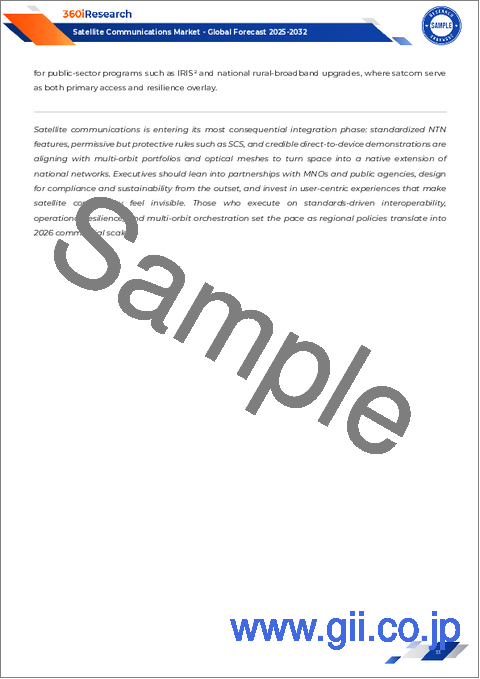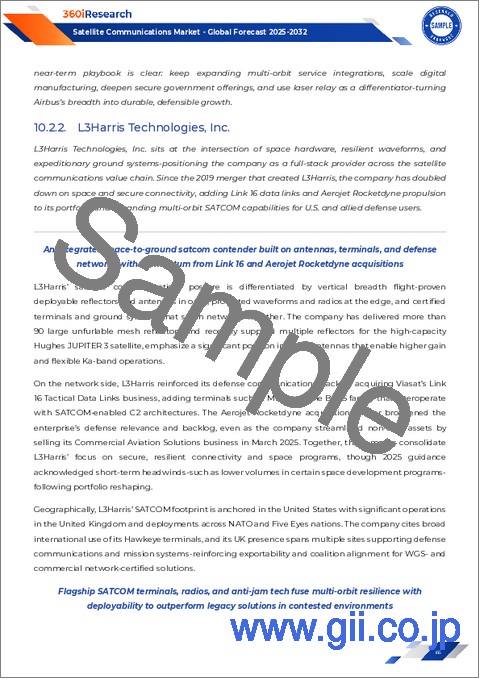|
|
市場調査レポート
商品コード
1827473
衛星通信市場:コンポーネントタイプ、軌道タイプ、技術、周波数帯域、用途、エンドユーザー、市場チャネル別 - 2025年~2032年の世界予測Satellite Communications Market by Component Type, Orbit Type, Technology, Frequency Band, Application, End-User, Market Channel - Global Forecast 2025-2032 |
||||||
カスタマイズ可能
適宜更新あり
|
|||||||
| 衛星通信市場:コンポーネントタイプ、軌道タイプ、技術、周波数帯域、用途、エンドユーザー、市場チャネル別 - 2025年~2032年の世界予測 |
|
出版日: 2025年09月30日
発行: 360iResearch
ページ情報: 英文 194 Pages
納期: 即日から翌営業日
|
概要
衛星通信市場は、2032年までにCAGR 10.76%で1,727億2,000万米ドルの成長が予測されています。
| 主な市場の統計 | |
|---|---|
| 基準年2024 | 762億1,000万米ドル |
| 推定年2025 | 837億6,000万米ドル |
| 予測年2032 | 1,727億2,000万米ドル |
| CAGR(%) | 10.76% |
衛星通信システム全体の調達と運用の優先順位を再定義する戦略的背景と技術的変曲点の明確で実行可能なフレーミング
衛星通信分野は、加速する技術革新と進化する規制や地政学的ダイナミクスが交錯する極めて重要な岐路にあります。ネットワーク・アーキテクチャは古典的な静止モデルから低・中軌道コンステレーションの急増へと移行しつつあり、地上インフラの近代化とソフトウェア定義ペイロードは容量とサービスの提供方法を再構成しつつあります。こうした変遷の中で、産業、防衛、政府の利害関係者は、俊敏性、回復力、相互運用性を優先する調達アプローチを再調整しています。
本レポートのイントロダクションでは、現在の投資パターンを支えている、商業的な要請と国家安全保障の優先事項の、より広範なコンバージェンスの中に読者を位置づける。また、システム統合、ライフサイクルサポート、データ主導のサービスモデルがこれまで以上に重要である理由を整理し、高スループット衛星、ビームフォーミング、エッジ処理における新たな能力が、新たな使用事例をいかに解き放つかを説明しています。また、高スループット衛星、ビームフォーミング、エッジプロセッシングといった新たな能力が、どのように新たなユースケースを解き放つのかについても解説しています。
衛星通信の競争力学と戦略的優先順位を再構築する技術、サプライチェーン、規制の同時変遷の説得力ある統合
衛星通信を取り巻く環境は、技術的な加速、サプライチェーンの再編、政策環境の変化という3つの集約的な力によって変容しつつあります。小型化、デジタル・ペイロード、打上げ経済性の進歩は、参入障壁を下げ、実現可能なコンスタレーション・アーキテクチャーの範囲を拡大し、より多様な競争エコシステムを作り出しています。同時に、サービスモデルは、モノリシックな長期サイクルのプロジェクトから、段階的な能力向上とユーザーニーズへの迅速な対応を可能にするモジュール化されたソフトウェア中心のサービスへと移行しつつあります。
サプライチェーンは、バイヤーが単一ソースへの依存や地政学的な混乱にさらされる機会を減らそうとしているため、意図的な再調達と多様化が進んでいます。この進化は、サプライヤーにロジスティクス戦略の再設計、デュアルソーシングへの投資、元請け企業やインテグレーターとの緊密な協力関係の追求を促しています。規制の観点からは、周波数帯管理、輸出規制、コンステレーション調整がより重要視されるようになり、各省庁は相互運用性とサイバー耐性の要件を厳しくしており、それがシステム設計と調達スケジュールを形作っています。これらのシフトを総合すると、競合の力学が再構築され、従来の既存事業者は適応を迫られるか、戦略的関連性が損なわれるリスクを負うことになります。
2025年の関税措置が衛星通信事業者全体の調達慣行、サプライヤーの多様化、プログラム・リスク管理をどのように変化させたかの分析評価
2025年の米国による関税の賦課と引き上げは、衛星通信の調達、ソーシング、プログラム実行に波及する重大な逆風をもたらしたが、必ずしも接続性に対する根本的な需要は変化しませんでした。製造業者や元請け業者は部品コストや組立コストの上昇圧力に見舞われ、多くの業者はサプライヤーのポートフォリオを見直し、フレンド・ショアリングやニア・ショアリングの代替ベンダーの認定を加速させました。その結果、重要なサブシステムのコンプライアンスと出所を確認するためのデューデリジェンスが行われる一方で、調達サイクルは長期化しました。
これに対応するため、多くの組織は、エンドユーザーへの関税の転嫁を緩和するために、サプライチェーンの透明性ツールや契約メカニズムへの投資を増加させました。プログラム・マネジャーは、短期的なコスト吸収と長期的な契約上の保護とのトレードオフのバランスを調整し、エンジニアリング・チームは、より広範なコンポーネントのベースとの互換性を可能にするために、デザイン・フォー・サプライ・アプローチを優先しました。政策の不確実性は、戦略的な在庫の決定と、一時的な関税の上昇をヘッジするための複数年の調達契約をも促しました。重要なのは、こうした調整によって、限界コストの削減よりも回復力と予測可能性が重視されたことで、関税引き上げ後の事業環境では、事業の継続性と規制遵守が支配的な判断基準となったことを示しています。
綿密なセグメンテーション分析により、コンポーネントの種類、軌道クラス、技術、周波数帯、アプリケーション、エンドユーザー、チャネルが、衛星のバリューチェーン全体においてどのように差別化された戦略的選択を促すかを明らかにします
セグメンテーションに基づく洞察は、コンポーネント、軌道、技術、周波数、アプリケーション、エンドユーザー、流通チャネルにわたる複雑さとニュアンスを明らかにします。機器にはアンプ、アンテナ、レシーバー、トランスミッターが含まれ、サービスには放送サービス、固定衛星サービス(FSS)、マネージドサービス、移動衛星サービス(MSS)、トランザクションサービスが含まれます。機器サイクルはハードウェアの更新と適格性確認に一致するのに対し、サービスは契約ケイデンス、期待される遅延、ソフトウェアの進化に支配されます。
静止軌道は永続的なカバレッジ・フットプリントを提供し、低軌道、中軌道、高軌道は新しい使用事例を可能にする低遅延、高密度接続モデルを促進します。技術区分では、地上局装置、SATCOM装置、衛星画像、合成開口レーダー(SAR)、トランスポンダー、超小型開口端末(VSAT)システムが注目され、それぞれが独自の統合とライフサイクルをもたらします。Cバンド、Kaバンド、Kuバンド、Lバンドにまたがる周波数帯域の区分は、RF計画、規制クリアランス、端末設計を形成し、アプリケーションの区分は、資産の追跡と監視、放送、データのバックアップとリカバリ、音声通信(後者には衛星電話とVoIPサービスが含まれる)にまたがり、技術的選択がビジネス要件にどのように対応するかを示しています。
商業顧客、防衛機関、政府機関、海事オペレーター、宇宙科学機関、輸送会社など、エンドユーザーのバリエーションは顕著で、それぞれに合わせたサービス保証、認証経路、セキュリティ態勢を要求しています。デジタル・チャネルはコモディティ化した端末の採用を加速させ、ダイレクト・エンゲージメント・モデルは企業や政府機関向けのオーダーメイドのソリューションを促進します。このようなセグメンテーションを行うことで、利害関係者は、どこに投資すれば経営上・競合上最大のリターンが得られるか、また、セグメント間のシナジーを活かしてバンドル商品や拡張性のあるサービスプラットフォームを構築できるかを見極めることができます。
南北アメリカ、欧州、中東・アフリカ、アジア太平洋の各地域で、戦略的優先順位を形成する産業上の強み、規制体制、需要パターンを概説する高度な地域的視点
地域別分析では、南北アメリカ、欧州、中東・アフリカ、アジア太平洋における多様な促進要因と制約を浮き彫りにし、それぞれに異なる規制、産業、市場参入に関する考慮事項を提示します。南北アメリカでは、強力な国内製造能力と、主権供給と同盟国システムとの相互運用性を重視する活発な防衛調達サイクルによって、プログラムの近代化と商業的需要が強化されています。こうした力学は、大規模な配備のための垂直統合的アプローチや元請け企業との戦略的パートナーシップを後押ししています。
欧州、中東・アフリカでは、先進技術の採用と異質な規制の枠組みが混在しています。欧州諸国は周波数帯の調整と国境を越えたサービスの調和を重視し、中東諸国はGEOとLEOの両ソリューションの採用を加速させる野心的な接続性と宇宙科学のイニシアチブを追求しています。アフリカでは、海事、農村、輸送の各分野で高い成長率の接続ニーズがあり、マネージド・サービスやVSAT主導のラストマイル・ソリューションの機会が創出されています。アジア太平洋地域は、大規模な製造能力と積極的な商業衛星プログラム、独自の周波数割り当て環境を併せ持ち、コンステレーション調整と地上インフラ拡張のための激しい競争と協力的な地域イニシアチブの両方をもたらしています。これらの地域的輪郭を総合すると、製造、パートナーシップ、規制への関与への投資がどこで最も大きな効果を生むかがわかる。
戦略的競合情勢のレビュー:既存企業と反主流企業が、差別化された価値を獲得するために、モジュラーアーキテクチャ、ソフトウェア定義機能、およびパートナーシップをどのように活用しているかを示します
競合情報は、既存企業と機敏な課題者が混在し、製品ロードマップ、サービスポートフォリオ、パートナーシップを形成していることを示しています。大手機器プロバイダーは、デジタルペイロードアーキテクチャ、モジュール式地上セグメントコンポーネント、および大規模なプログラムインテグレーターの統合リスクを軽減するライフサイクルサービス提供への投資を続けています。同時に、革新的な参入企業は、より低遅延のサービスプロビジョニングと迅速な機能展開を実現するために、ソフトウェア定義無線、クラウドネイティブな地上システム、自動化されたオペレーションを活用しています。
戦略的提携と垂直統合は顕著なテーマであり、サプライヤーは地上システムインテグレーター、Platform-as-a-Serviceプロバイダー、マネージドサービスオペレーターと技術提携を結び、エンド・ツー・エンドの価値提案を行っています。国防と政府の調達サイクルは、セキュリティとサプライチェーンの保証を優先する技術移転契約と認定生産ラインを促しています。競合情勢全体では、ソフトウェア能力、システムエンジニアリングの専門知識、微妙な規制状況やセキュリティ要件を満たしながらグローバルに事業を拡大する能力などが、ますます差別化の中心になっています。
サプライチェーンの強靭性を強化し、ソフトウェア主導の近代化を加速し、規制との整合性を確保して持続的な優位性を確保するために、経営幹部がとるべき実践的で優先順位の高い戦略的行動
業界のリーダーは、当面のレジリエンス対策と中期的な能力投資のバランスをとるポートフォリオ・アプローチを追求すべきです。まず、サプライチェーンの透明性とデュアルソーシング・プロトコルを調達実務に組み込み、重要なサブシステムの認定スケジュールを維持しながら、貿易政策の変動にさらされる機会を減らします。次に、ペイロードと地上システムのソフトウェア中心のロードマップを加速させ、機能の提供を長いリードタイムのハードウェアサイクルから切り離すことで、顧客のニーズや規制の変化への対応力を向上させる。
さらに、相互運用性と規格の整合性を優先させることで、統合コストを削減し、進化するミッション要件に対応できるマルチベンダー・エコシステムを実現します。RFエンジニアリング、クラウドオペレーション、サイバーハードニングを融合させた、ますますハイブリッド化するシステムをチームが管理できるように、人材開発と領域横断的なエンジニアリング能力に投資します。最後に、規制当局や提携パートナーと積極的に連携し、周波数政策、輸出規制の明確化、認証の枠組みを策定することで、商用および政府プログラムの両方について、導入までの時間を短縮します。これらのステップを踏むことで、企業は現在のディスラプションを競争優位に転換し、長期的な戦略的関連性を維持することができます。
一次インタビュー、技術的統合、政策分析を組み合わせた透明で再現可能な調査手法の枠組みにより、意思決定者のための実用的かつ検証可能な洞察を得ることができます
調査手法は、1次質的インタビュー、技術文献の統合、および分野横断的な政策分析を組み合わせることで、結論が業務上の現実と文書化された規制動向を確実に反映するようにしています。一次調査では、商業、政府、防衛の各組織のシステム設計者、調達責任者、運用管理者との構造化インタビューを行い、意思決定の促進要因、統合の課題、調達行動を把握しました。これらの会話は、技術白書、標準化団体の出版物、および一般に入手可能な規制当局の提出書類の徹底的なレビューによって補足され、権威ある情報源に基づいた分析が行われました。
分析手法は三角測量に重点を置き、インタビューから得られた知見を技術仕様や調達フレームワークと照らし合わせて検証し、一貫したパターンや明らかになった乖離を特定しました。リスク分析と感度分析をサプライチェーンと政策のシナリオに適用し、関税と貿易政策のシフトに対する組織の対応を評価しました。また、この調査手法には、ベンダーとケイパビリティのマッピングも含まれており、技術スタック、サービスモデル、チャネル戦略によって企業を分類し、競合のポジショニングとパートナーシップの機会を多角的に捉えることができるようにしました。アプローチに透明性を持たせることで、再現性を確保し、意思決定者にとって実用的な妥当性を確保しました。
政策やサプライチェーンが複雑化する中、競争力を維持するためには、弾力性、相互運用性、ソフトウェア中心の近代化が必要であることを強調する結論的な統合
結論として、衛星通信の状況は、ますます複雑化する政策環境を背景に、よりモジュール化されたソフトウェア主導のアーキテクチャと地域的に多様化するサプライチェーンへと移行しつつあります。弾力性、相互運用性、サービスの柔軟性を戦略的に重視することで、どの組織が新たな運用上の制約や競争圧力にうまく適応できるかが決まる。最近の貿易措置と規制強化の累積的効果は、組織の優先順位を短期的なコスト競争から、持続的な業務の確実性と安全な調達へとシフトさせています。
デュアルソーシング、ソフトウエア定義のオペレーション、積極的な規制への関与に投資する組織は、商業的・ミッションクリティカルな機会を獲得する上で有利な立場になると思われます。逆に、シングルソースの供給モデルに固執したり、地上およびペイロードソフトウェアの近代化を遅らせたりする企業は、調達サイクルが長期化し、機敏性が低下するリスクがあります。全体として、戦略的明確化、規律ある実行、的を絞った技術投資は、勢いを維持し、次世代衛星通信の約束を実現するために不可欠です。
目次
第1章 序文
第2章 調査手法
第3章 エグゼクティブサマリー
第4章 市場の概要
第5章 市場洞察
- LEO衛星群の普及により、遠隔地でも世界規模の低遅延ブロードバンドカバレッジが可能に
- 軌道上で再構成可能なペイロードと動的なリソース割り当てを備えたソフトウェア定義衛星の採用増加
- 衛星通信と5Gネットワークの統合により、自動車およびIoTアプリケーションの接続性が強化されます。
- 長期的な衛星群の健全性を維持するための衛星サービスと宇宙状況認識への投資の増加
- データスループットを向上させ、地上局インフラへの依存を減らすレーザー衛星間リンクの出現
- 世界中でアクセスしやすく費用対効果の高いミッション展開を推進する小型衛星打ち上げサービスの開発
- デジタルビームフォーミング技術の進歩により、コンステレーション全体の帯域幅割り当てとネットワークパフォーマンスが最適化されます。
第6章 米国の関税の累積的な影響, 2025
第7章 AIの累積的影響, 2025
第8章 衛星通信市場:コンポーネントタイプ別
- 装置
- 増幅器
- アンテナ
- 受信機
- 送信機
- サービス
- 放送サービス
- 固定衛星サービス(FSS)
- マネージドサービス
- モバイル衛星サービス(MSS)
- トランザクションサービス
第9章 衛星通信市場:軌道タイプ別
- 静止軌道(GEO)
- 高地球軌道(HEO)
- 低軌道(LEO)
- 中軌道(MEO)
第10章 衛星通信市場:技術別
- 地上局設備
- 衛星通信機器
- 衛星画像
- 合成開口レーダー(SAR)
- トランスポンダー
- 超小型衛星端末(VSAT)
第11章 衛星通信市場:周波数帯域別
- Cバンド
- Kaバンド
- Kuバンド
- Lバンド
第12章 衛星通信市場:用途別
- 資産追跡/監視
- 放送
- データのバックアップと復元
- 音声通信
- 衛星電話
- VoIPサービス
第13章 衛星通信市場:エンドユーザー別
- 商業
- 防衛
- 政府
- 海事
- 宇宙科学
- 輸送
第14章 衛星通信市場:市場チャネル別
- 直接販売
- 販売代理店
- eコマース
- 小売り
第15章 衛星通信市場:地域別
- 南北アメリカ
- 北米
- ラテンアメリカ
- 欧州・中東・アフリカ
- 欧州
- 中東
- アフリカ
- アジア太平洋地域
第16章 衛星通信市場:グループ別
- ASEAN
- GCC
- EU
- BRICS
- G7
- NATO
第17章 衛星通信市場:国別
- 米国
- カナダ
- メキシコ
- ブラジル
- 英国
- ドイツ
- フランス
- ロシア
- イタリア
- スペイン
- 中国
- インド
- 日本
- オーストラリア
- 韓国
第18章 競合情勢
- 市場シェア分析, 2024
- FPNVポジショニングマトリックス, 2024
- 競合分析
- Airbus SE
- Al Yah Satellite Communications Company PJSC
- ASELSAN A.S.
- AST & Science, LLC
- AvL Technologies
- Campbell Scientific, Inc.
- Cobham Limited
- Comtech Telecommunications Corp.
- CPI International Inc.
- EchoStar Corporation
- Eutelsat S.A.
- General Dynamics Mission Systems, Inc.
- Gilat Satellite Networks Ltd.
- Globalstar, Inc.
- Holkirk Communications Ltd
- Honeywell International Inc.
- Indra Sistemas, S.A.
- Intellian Technologies, Inc.
- Intelsat US LLC
- Iridium Communications Inc.
- L3Harris Technologies, Inc.
- Ligado Networks
- Maxar Technologies Holdings Inc.
- Network Innovations Inc.
- Qualcomm Incorporated
- SES S.A.
- SKY Perfect JSAT Holdings Inc.
- ST Engineering
- Telesat Corporation
- The Marlink Group
- Viasat, Inc.
- Viking SatCom





